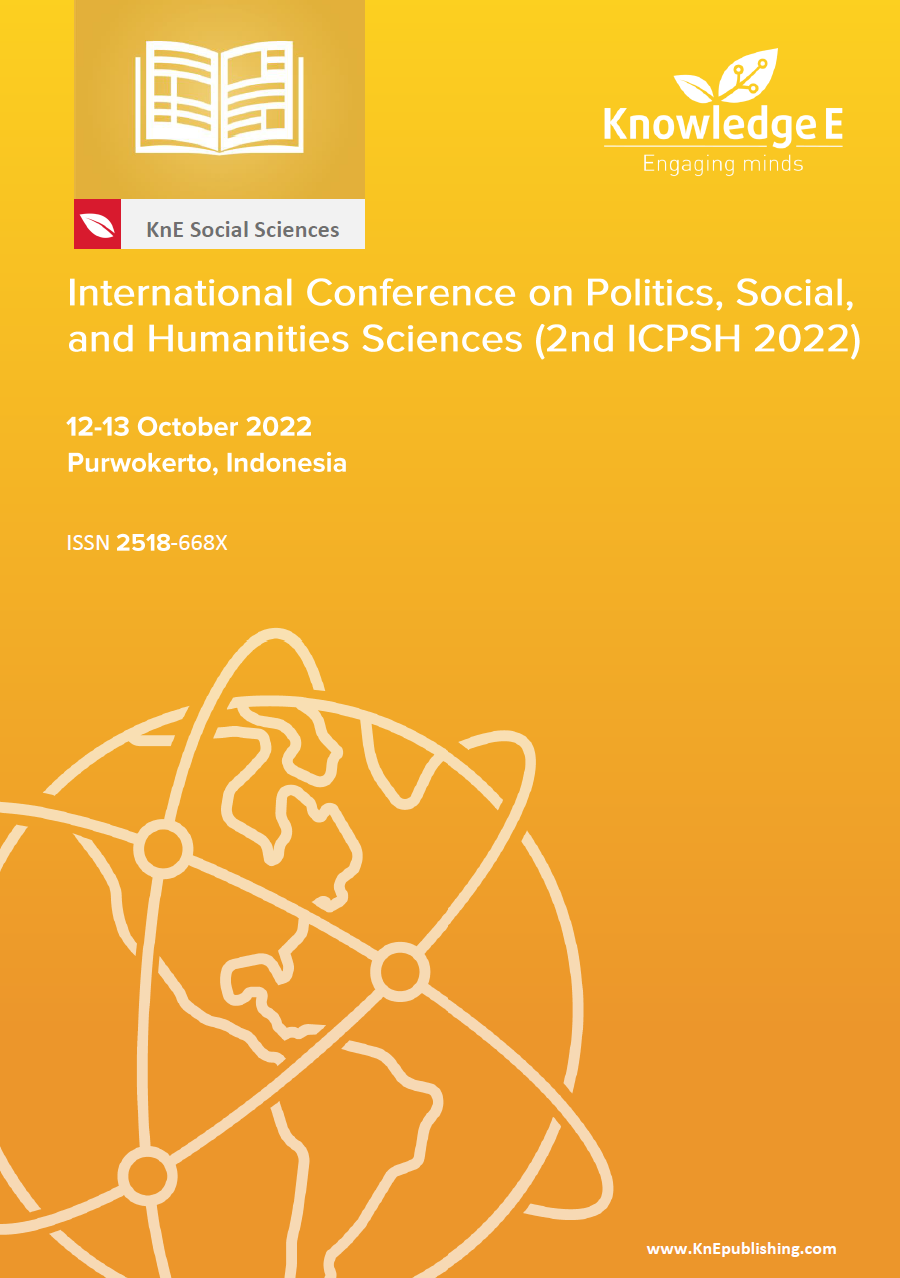Social Capital For Rural Community During the Covid-19 Pandemic in Banyumas Regency
DOI:
https://doi.org/10.18502/kss.v8i3.12848Abstract
The COVID-19 pandemic has significantly impacted Indonesian society. In addition to having an effect on the community’s socioeconomic aspects, it also has an effect on the health aspect. The most important factor in preventing and managing the effects of COVID-19 is how to foster social cohesion and make use of all community resources, especially its social capital. Finding out the social capital of rural communities amid the current COVID-19 outbreak is therefore urgently needed. This study’s specific goal is to examine the social capital that exists in rural Banyumas Regency villages during the COVID-19 pandemic and how such social capital influences local activities and rural populations’ social relations. A case study technique and a descriptive qualitative methodology were used to perform this study. The researcher will conduct in-depth interviews and direct observations to gather data. The Banyumas Regency’s rural settlements will be chosen for the study depending on the researcher’s criteria (purposive sampling). The findings demonstrated that several Banyumas Regency village areas had powerful social capital through social networks and community trust. Still, different things also occurred in several other regions, where the level of trust between community members had decreased since the pandemic. The social network that should exist in the community disintegrates or fails to form due to the drop in confidence.
Keywords: Social Capital, Village Community, COVID-19 Pandemic
References
19 STPC. Peta Sebaran COVID-19. 2021.
JDIH BPK. Permenkes No. 9 Tahun 2020 tentang Pedoman Pembatasan Sosial Berskala Besar Dalam Rangka Percepatan Penanganan Corona Virus Disease 2019. Parallax. 2020;:9–19.
Putra IM. Modal sosial dalam pemberdayaan Desa Pakraman (Studi kasus pengelolaan LPD Desa Pakraman Batuaji Kawan, Kabupaten Tabanan Propinsi Bali). Universitas Gadjah Mada; 2009.
Hasbullah J. Social capital: Menuju keunggulan budaya manusia Indonesia. Jakarta: MR-United Press; 2006. 30 pp.
Putnam RD. Tuning In, Tuning Out: The Strange Disappearance of Social Capital in America. PS Polit Sci Polit. 1996 Dec;28:47.
Fukuyama F. Social capital, civil society and development. Third World Q. 2001 Feb;22(1):7–20.
Kushandajani. Otonomi Desa Berbasis Modal Sosial dalam Perspektif Socio-Legal. Mustaqim, Astuti P, Hilya A, editors. Jurusan Ilmu Pemerintahan Fakultas Ilmu Sosial dan Ilmu Politik (FISIP); 2008.
Pranadji T. Penguatan modal sosial untuk pemberdayaan masyarakat pedesaan dalam pengelolaan agroekosistem lahan kering (Studi Kasus di Desa-desa Ex Proyek Bangun Desa dan Ex Proyek Pertanian Lahan Kering, Kabupaten Boyolali). Pus Anal Sos Ekon dan Kebijak Pertan. 2006;24(2):178–206.
Peran Modal Sosial NS. (Social Capital) Dalam Perdagangan Hasil Pertanian. J Forum Penelit Agroekonomi. 2008;26(1):32–43.
Mawardi M. Peranan Social Capital dalam Pemberdayaan Masyarakat. J Pengemb Masy Islam. 2007;3(2):126–35.
Field J. Modal Sosial. Yogyakarta: Kreasi Wacana; 2010. 17 pp.
Paldam M. Social Capital: One or Many? Definition and Measurement. J Econ Surv. 2000 Dec;14(5):119–24.
Putnam RD. Bowling alone: The collapse and revival of American community. New York: Simon and Schuster; 2000.
Lesser E. Leveraging Social Capital in Organizations. Knowledge and Social Capital. 1st Editio. Boston: Butterworth-Heinemann; 2000. p. 14.
Faedlulloh D. Modal Sosial dan Praktik Gotong Royong Para Pengrajin Gula Kelapa di Desa Ketanda Kabupaten Banyumas. Publisia J Ilmu Adm Publik. 2017;2(2).https://doi.org/10.26905/pjiap.v2i2.1467.
Setiyawan KB. Social Capital in Community Forest Management: Case Study in Berjo Village Ngargoyoso, Karanganyar, Central Java. J Sos Ekon Pertan. 2019;15(2):156–63.
Laura N, Sari RD, Setiawan I, Herdiyanti H. Peran Modal Sosial Masyarakat dalam Pengelolaan Potensi Alam Sebagai Strategi Bertahan Hidup di Dusung Limang, Kecamatan Kelapa, Kabupaten Bangka Barat. Society. 2018;6(2):74–82.
Regus M. Pentingnya Revitalisasi Modal Sosial Paska Pandemi Covid-19. J Kependud Indones. 2020 Apr;2(1):11–4.
Puspita DR, Dharma P, Nuraini H. Ketahanan Keluarga di Masa Pandemi COVID-19 di Kabupaten Banyummas. Pros Semin Nas dan Call Pap [Internet]. 2020;10(Ketahan Keluarga):123–30. Available from:http://www.jurnal.lppm.unsoed.ac.id/ojs/index.php/Prosiding/article/view/1339
Moleong LJ. Metodologi Penelitian Kualitatif. Cetakan Ke. Bandung: PT.Remaja Rosdakarya; 1999. 57 p.
Cresswell JW. Research Design Pendekatan Kualitatif, Kuantitatif, dan Mixed. Yogyakarta: Pustaka Pelajar; 2015. 39 pp.
Williams SN, Armitage CJ, Tampe T, Dienes K. Public perceptions and experiences of social distancing and social isolation during the COVID-19 pandemic: a UK-based focus group study. BMJ Open. 2020 Jul;10(7):e039334.
Ritzer G, Goodman DJ. Teori sosiologi: Dari teori sosiologi klasik sampai perkembangan mutakhir teori sosial postmodern. Yogyakarta: Kreasi Wacana; 2009.
Syahra R. Modal sosial: Konsep dan aplikasi. J Masy dan Budaya. 2003;5(1):1–22.
Buana RD. Analisis Perilaku Masyarakat Indonesia dalam Menghadapi Pandemi COVID-19 dan Kiat Menjaga Kesejahteraan Jiwa. Sos dan Budaya, Fak Syariah dan Huk Univ Islam Negeri Syarif Hidayatullah Jakarta. 2017;53(9):1689–99.
Burt RS. The Network Structure Of Social Capital. Res Organ Behav. 2000;22:345– 423.
Shaw R, Nakagawa Y. Social Capital: A Missing Link to Disaster Recovery. Int J Mass Emerg Disasters. 2004;22(1):5–34.
Wagiran. Pengembangan Karakter Berbasis Kearifan Lokal Hamemayu Hayuning Bawana. J Pendidik Karakter. 2012;3(3):329–39.
Azzet AM. Urgensi pendidikan karakter di Indonesia. Yogyakarta: Ar-Ruzz Media; 2011.

